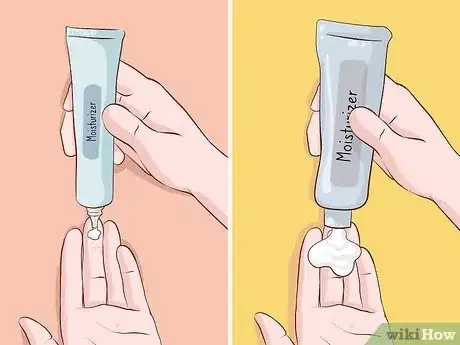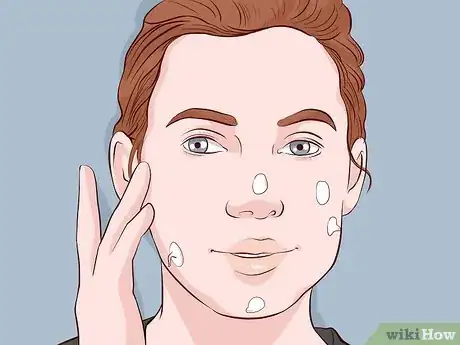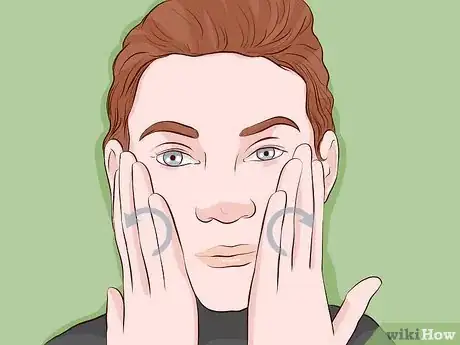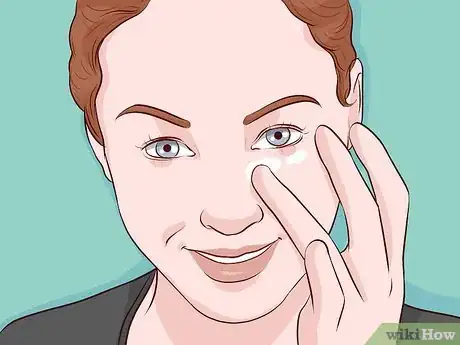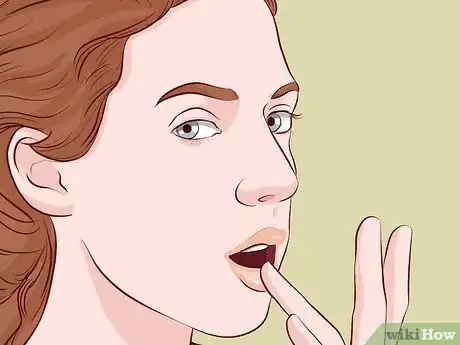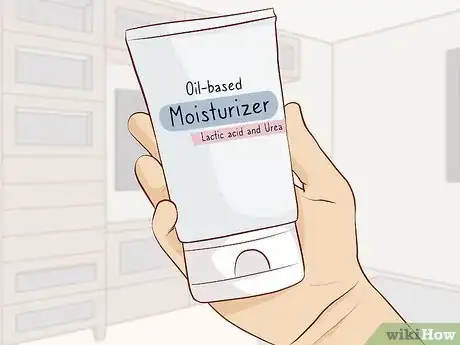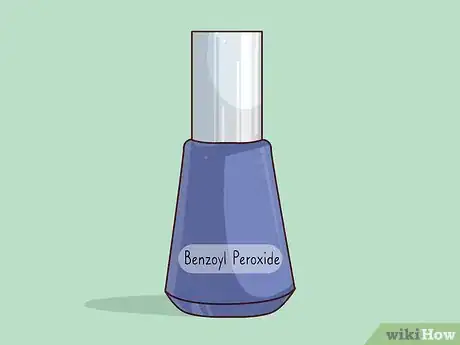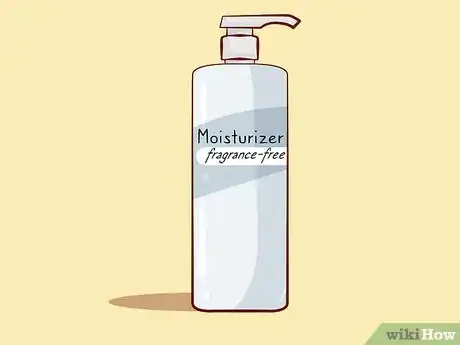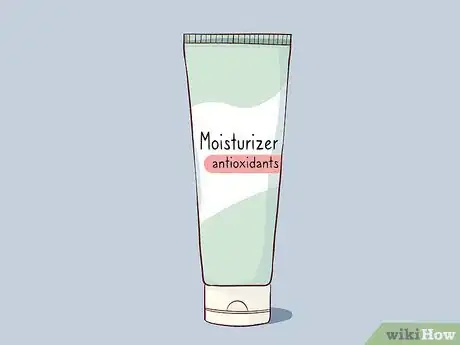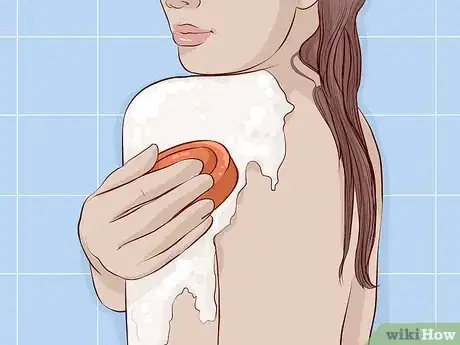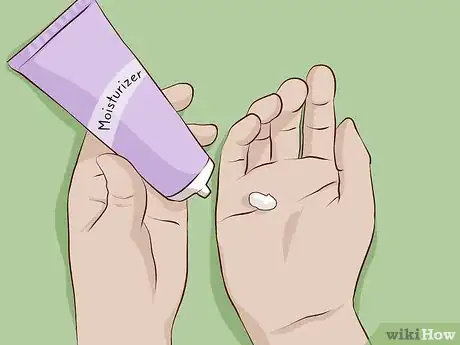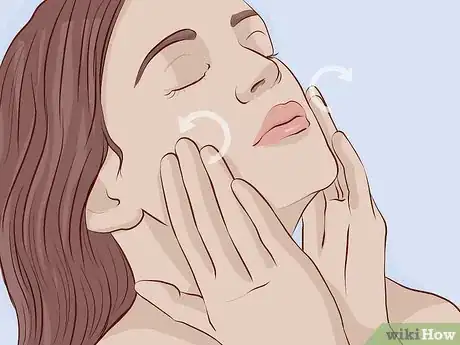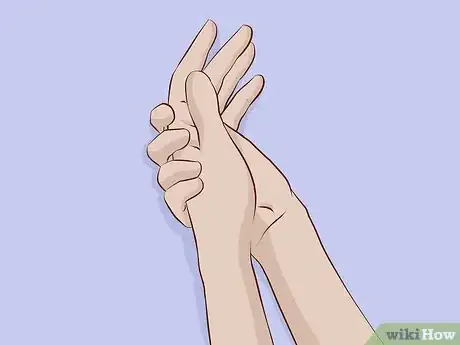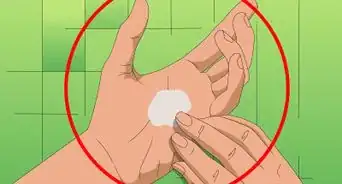This article was co-authored by Mohiba Tareen, MD and by wikiHow staff writer, Amber Crain. Mohiba Tareen is a board certified Dermatologist and the founder of Tareen Dermatology located in Roseville, Maplewood and Faribault, Minnesota. Dr. Tareen completed medical school at the University of Michigan in Ann Arbor, where she was inducted into the prestigious Alpha Omega Alpha honor society. While a dermatology resident at Columbia University in New York City, she won the Conrad Stritzler award of the New York Dermatologic Society and was published in The New England Journal of Medicine. Dr. Tareen then completed a procedural fellowship which focused on dermatologic surgery, laser, and cosmetic dermatology.
There are 18 references cited in this article, which can be found at the bottom of the page.
wikiHow marks an article as reader-approved once it receives enough positive feedback. In this case, 100% of readers who voted found the article helpful, earning it our reader-approved status.
This article has been viewed 411,856 times.
Moisturizer protects your skin from the elements and keeps it hydrated so it looks and feels healthy. Typically, you need to apply different types of moisturizer for your face and body since the skin on your face is a lot more sensitive. It’s also important to apply moisturizers to clean skin in a particular order for the most hydrating benefits!
Steps
Using Facial Moisturizer
-
1Wash your face with lukewarm water to prepare your skin. The best time to apply moisturizer is when your skin is clean.[1] Work a gentle face cleanser into a lather and rinse it off thoroughly with lukewarm water. Gently pat your skin with a soft, clean towel to remove excess moisture. Don’t completely dry your skin, though! Leave it damp.[2]
-
2Use an almond-sized amount of product for each application. The amount of moisturizer to use varies by product. In general, thinner moisturizers can be applied more generously since your face absorbs them quickly. If you’re using a really thick moisturizer, a small dollop should do the trick. If you aren't sure where to start, go with an almond-sized amount of product.[5]
- You might need a thick cream if you’re dealing with a skin condition like psoriasis, eczema, or rosacea.
- Day creams are typically thinner, while night creams are thicker.
- You can find a rich moisturizer that works for both morning and night here.
- You can also try using face cream with CBD for a calming effect. Popular brands include CBD American Shaman and Charlotte's Web.
-
1
- Use moisturizer with SPF 30 to protect your face and body during the day. Damage from the sun can lead to premature aging.[7]
-
2Dab a small amount of the moisturizer on different areas of your face. Use clean fingertips to apply small dabs of the moisturizer onto key dry areas like your forehead, cheeks, nose, and chin. This helps to distribute the product evenly all over your face.[8]
- Don't forget to include your neck in both your washing and moisturizing routine. This is especially important when you're apply a daytime moisturizer with SPF, which will help protect these areas from sun damage.
-
3Spread the moisturizer evenly around your face with your fingertips. Using your fingertips, smooth each dab of moisturizer upwards and outwards on your face using circular motions. You only need to apply gentle pressure to blend the moisturizer into your skin evenly. Be extra careful around the delicate eye area.[9]
- Allow the moisturizer to absorb completely before applying makeup or other products.
-
4Tap eye cream into the skin around your eyes with your ring finger. The skin around your eyes is thinner and more sensitive than the skin anywhere else on your body. Because of this, many people like to apply a special cream to this area. If you want to try eye cream, use your middle or ring finger to dab a small amount around the eye area. Continue tapping the cream into your skin until it's completely absorbed.[10]
- Give the cream about a minute to fully absorb before moving on to your regular moisturizer.
- For daytime, you can apply your usual SPF moisturizer around your eyes.[11]
- Avoid pulling or tugging the delicate skin around your eyes.
- Look for eye creams made with ingredients like retinoids, hyaluronic acid, ceramides, neuropeptides, and vitamin E.[12]
-
5Apply lip balm to your lips to moisturize and protect them. Just like the rest of your skin, your lips need to maintain moisture in order to stay hydrated and look great. Use a moisturizing lip balm to keep your lips soft and plump. Carry it with you and reapply as needed throughout the day. You can even wear it under your lipstick.[13]
- Consider using a lip balm that contains SPF if you plan on going outdoors.
- If the lip balm makes your lips tingle or feels uncomfortable, you may want to try something else on the sensitive lip area.
Choosing the Best Moisturizer for Your Skin Type
-
1Go with a water-based moisturizer if you have normal skin. Normal skin is able to maintain a natural moisture balance. If you have normal skin, you rarely deal with issues like excessive oiliness or dry, flaky skin. You only need a light, water-based moisturizer to keep your skin looking fresh.[14]
- Water-based moisturizers never feel greasy. They often contain lightweight oils or silicone-derived ingredients.
-
2Select a heavier oil-based moisturizer if you have dry skin. Dry skin is usually flaky, itchy, and rough to the touch. Very dry skin may even crack and be painful. You need something a little heavier to restore hydration to dry skin, so go with a thick, oil-based moisturizer.[15]
-
3Try a light, water-based moisturizer if you have oily skin. If you have oily skin, you have shiny patches of oil in one or more places, normally on your face. Oily skin tends to be more susceptible to acne, so use a light, water-based moisturizer that won't clog your pores. Look for a product that say "oil-free" and "non-comedogenic" on the label.[18]
- Moisturizer is especially important if you're using an acne medication that contains drying ingredients like benzoyl peroxide or salicylic acid.[19]
- If you're acne-prone, avoid moisturizers that contain pore-clogging ingredients like petroleum jelly, cocoa butter, and coconut oil.
-
4Use a moisturizer with soothing ingredients if you have sensitive skin. If your skin is susceptible to irritation, redness, itching, or rashes, go with a soothing moisturizer made with chamomile or aloe. Look for products that say "hypoallergenic" and "fragrance-free" on the label.[20]
- Avoid products containing acids, which can irritate sensitive skin.
-
5Try oil-based moisturizers with antioxidants if you have mature skin. As skin ages, the oil-producing glands slow down and skin becomes thinner and drier. Go with an oil-based product made with petroleum jelly to lock in moisture and reduce the appearance of fine lines and wrinkles. Moisturizers with antioxidants or alpha hydroxy acids can help prevent flaky skin.[21]
- Moisturizers with retinoids and peptides can also be great for mature skin.
Moisturizing Your Body
-
1Wash your body with gentle, moisturizing soap and warm water. Use a mild cleanser with moisturizing ingredients like shea butter and glycerin. Apply the cleanser to your body with a light touch to avoid damaging your skin. Lather it up and rinse your skin thoroughly with warm water. Use a soft towel to gently pat the excess moisture off your skin but leave the skin damp.[22]
-
2Squirt a quarter-sized amount of moisturizer into the palm of your hand. Rub the moisturizer between both palms for several seconds to spread the product evenly and warm it up a little. It’s best to start with a quarter-sized amount and continue to get more moisturizer, as needed.[25]
- You can find moisturizing body butter online here.
-
3Use both hands to apply moisturizer to clean, still-damp skin. Use short but firm strokes with your hands to spread the moisturizer over your body and smooth it into your skin. Be sure to apply moisturizer in the direction of the hair follicle and don’t rub too hard to avoid skin irritation.[26]
- Pay specific attention to the driest parts of your body like your elbows, knees, and feet.
-
4Reapply moisturizer to your hands each time after washing them. Every time you wash your hands, you remove the moisturizer you previously applied along with the natural oils and moisture in your skin. Get into the habit of applying hand cream every time after you wash your hands in order to keep them soft.[27]
Expert Q&A
Did you know you can get premium answers for this article?
Unlock premium answers by supporting wikiHow
-
QuestionWhy should I apply face moisturizer?
 Mohiba Tareen, MDMohiba Tareen is a board certified Dermatologist and the founder of Tareen Dermatology located in Roseville, Maplewood and Faribault, Minnesota. Dr. Tareen completed medical school at the University of Michigan in Ann Arbor, where she was inducted into the prestigious Alpha Omega Alpha honor society. While a dermatology resident at Columbia University in New York City, she won the Conrad Stritzler award of the New York Dermatologic Society and was published in The New England Journal of Medicine. Dr. Tareen then completed a procedural fellowship which focused on dermatologic surgery, laser, and cosmetic dermatology.
Mohiba Tareen, MDMohiba Tareen is a board certified Dermatologist and the founder of Tareen Dermatology located in Roseville, Maplewood and Faribault, Minnesota. Dr. Tareen completed medical school at the University of Michigan in Ann Arbor, where she was inducted into the prestigious Alpha Omega Alpha honor society. While a dermatology resident at Columbia University in New York City, she won the Conrad Stritzler award of the New York Dermatologic Society and was published in The New England Journal of Medicine. Dr. Tareen then completed a procedural fellowship which focused on dermatologic surgery, laser, and cosmetic dermatology.
FAAD Board Certified Dermatologist
-
QuestionWhat ingredients should I look for in a moisturizer?
 Mohiba Tareen, MDMohiba Tareen is a board certified Dermatologist and the founder of Tareen Dermatology located in Roseville, Maplewood and Faribault, Minnesota. Dr. Tareen completed medical school at the University of Michigan in Ann Arbor, where she was inducted into the prestigious Alpha Omega Alpha honor society. While a dermatology resident at Columbia University in New York City, she won the Conrad Stritzler award of the New York Dermatologic Society and was published in The New England Journal of Medicine. Dr. Tareen then completed a procedural fellowship which focused on dermatologic surgery, laser, and cosmetic dermatology.
Mohiba Tareen, MDMohiba Tareen is a board certified Dermatologist and the founder of Tareen Dermatology located in Roseville, Maplewood and Faribault, Minnesota. Dr. Tareen completed medical school at the University of Michigan in Ann Arbor, where she was inducted into the prestigious Alpha Omega Alpha honor society. While a dermatology resident at Columbia University in New York City, she won the Conrad Stritzler award of the New York Dermatologic Society and was published in The New England Journal of Medicine. Dr. Tareen then completed a procedural fellowship which focused on dermatologic surgery, laser, and cosmetic dermatology.
FAAD Board Certified Dermatologist
-
QuestionHow do you apply moisturizer on an oily face after washing?
 Jennifer Boidy, RNJennifer Boidy is a Registered Nurse in Maryland. She received her Associate of Science in Nursing from Carroll Community College in 2012.
Jennifer Boidy, RNJennifer Boidy is a Registered Nurse in Maryland. She received her Associate of Science in Nursing from Carroll Community College in 2012.
Registered Nurse Oily skin still needs moisture just like other types of skin, especially after washing. Using a lighter moisturizer, such as a lotion rather than a cream, is better for oily skin. Also be sure to choose a water-based lotion that is labeled non-comedogenic, which means it won’t clog your pores. After washing, pat your skin dry, and gently spread the lotion onto your face using your fingertips.
Oily skin still needs moisture just like other types of skin, especially after washing. Using a lighter moisturizer, such as a lotion rather than a cream, is better for oily skin. Also be sure to choose a water-based lotion that is labeled non-comedogenic, which means it won’t clog your pores. After washing, pat your skin dry, and gently spread the lotion onto your face using your fingertips.
Warnings
- Reapply SPF lotions every 2 hours or so to stay protected, especially if you're swimming or sweating a lot.[29]⧼thumbs_response⧽
References
- ↑ Mohiba Tareen, MD. FAAD Board Certified Dermatologist. Expert Interview. 26 March 2020.
- ↑ https://www.mayoclinic.org/diseases-conditions/dry-skin/in-depth/moisturizers/art-20044232
- ↑ https://medlineplus.gov/ency/patientinstructions/000751.htm
- ↑ https://www.utmedicalcenter.org/the-importance-of-moisturizing/
- ↑ https://www.today.com/style/how-much-skin-product-apply-serum-moisturizer-more-t105697
- ↑ https://health.clevelandclinic.org/day-or-night-what-to-look-for-in-a-facial-cream/
- ↑ Mohiba Tareen, MD. FAAD Board Certified Dermatologist. Expert Interview. 26 March 2020.
- ↑ https://www.today.com/style/how-much-skin-product-apply-serum-moisturizer-more-t105697
- ↑ https://www.marieclaire.com/beauty/news/a23093/rubbing-vs-pressing-skincare-method/
- ↑ https://www.instyle.com/beauty/properly-apply-eye-cream
- ↑ https://health.clevelandclinic.org/hello-bright-eyes-how-to-pick-the-eye-cream-thats-right-for-you/
- ↑ https://www.elle.com/beauty/makeup-skin-care/tips/a2447/skin-care-best-eye-cream-ingredients-383992/
- ↑ https://www.aad.org/dermatology-a-to-z/health-and-beauty/general-skin-care/dry-skin-tips
- ↑ https://www.mayoclinic.org/diseases-conditions/dry-skin/in-depth/moisturizers/art-20044232
- ↑ https://www.mayoclinic.org/diseases-conditions/dry-skin/in-depth/moisturizers/art-20044232
- ↑ Mohiba Tareen, MD. FAAD Board Certified Dermatologist. Expert Interview. 26 March 2020.
- ↑ https://nationaleczema.org/eczema/treatment/moisturizing/
- ↑ https://www.mayoclinic.org/diseases-conditions/dry-skin/in-depth/moisturizers/art-20044232
- ↑ https://www.aad.org/public/diseases/acne/skin-care/moisturizer
- ↑ https://www.mayoclinic.org/diseases-conditions/dry-skin/in-depth/moisturizers/art-20044232
- ↑ https://www.mayoclinic.org/diseases-conditions/dry-skin/in-depth/moisturizers/art-20044232
- ↑ https://www.health.harvard.edu/staying-healthy/9-ways-to-banish-dry-skin
- ↑ https://www.aad.org/public/diseases/a-z/dry-skin-self-care
- ↑ https://www.mayoclinic.org/diseases-conditions/dry-skin/in-depth/moisturizers/art-20044232
- ↑ https://www.skincare.com/article/the-best-time-to-apply-body-lotion
- ↑ https://www.ncbi.nlm.nih.gov/pmc/articles/PMC4885180/
- ↑ https://www.aad.org/dermatology-a-to-z/health-and-beauty/general-skin-care/dry-skin-tips
- ↑ https://www.aad.org/dermatology-a-to-z/health-and-beauty/general-skin-care/dry-skin-tips
- ↑ https://www.aad.org/public/everyday-care/sun-protection/sunscreen-patients/sunscreen-faqs
About This Article
Before applying moisturizer, wash your face or body to not only clean your skin but also to allow it to properly absorb the cream. Then, dab the moisturizer on key dry areas, such as your nose, chin, elbows, knees, and feet. However, if any of these areas are oily, avoid putting moisturizer on them. Finally, if you spend time outdoors and want to protect your skin from ultraviolet rays, pick a moisturizer that also contains sun protection through SPF content. For tips from our Medical reviewer on how to select the right moisturizer, keep reading!


